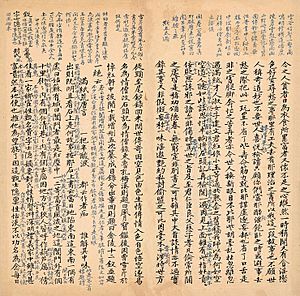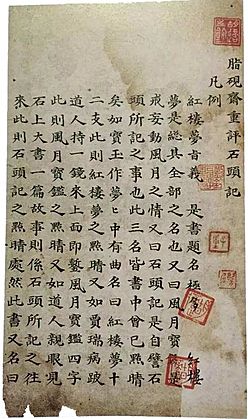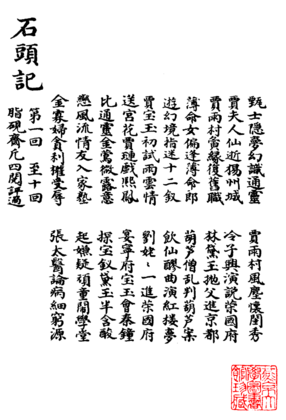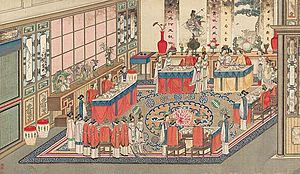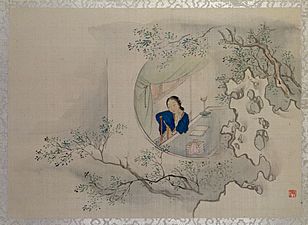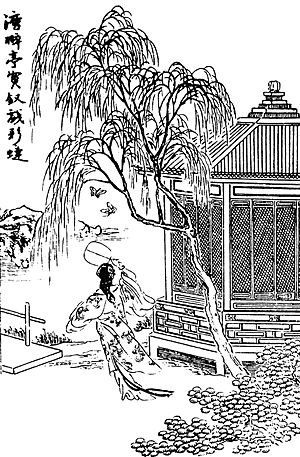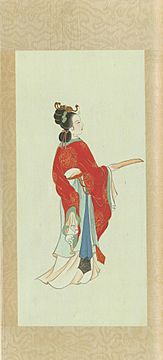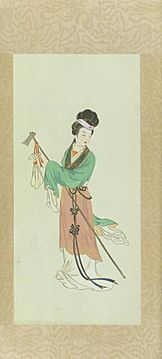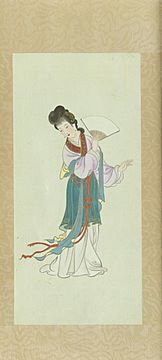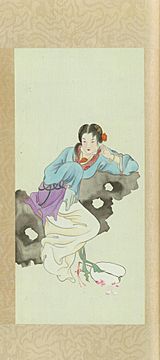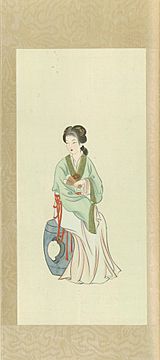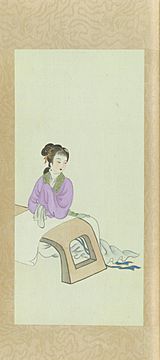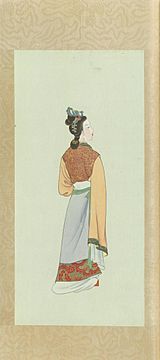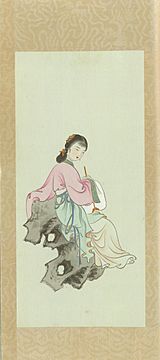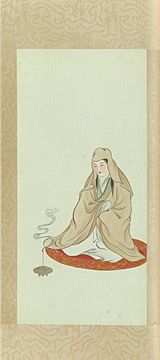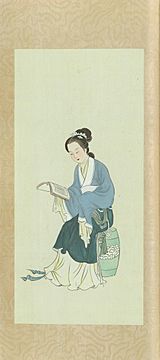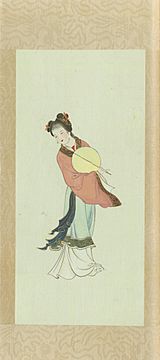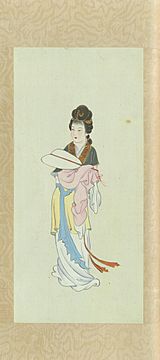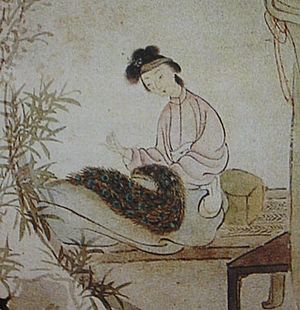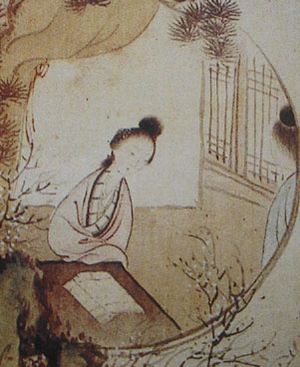Dream of the Red Chamber facts for kids
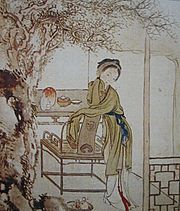
A scene from the novel, painted by Xu Baozhuan (1810–1873)
|
|
| Author | Cao Xueqin |
|---|---|
| Original title | 紅樓夢 |
| Country | Qing China |
| Language | Chinese |
| Genre | Novel, Family saga |
| Set in | China |
|
Publication date
|
mid-18th century (manuscripts) 1791 (first printed edition) |
|
Published in English
|
1868, 1892; 1973–1980 (1st complete English translation) |
| Media type | Scribal copies/Print |
| 895.1348 | |
| Dream of the Red Chamber | |||||||||||||||||||||||||||
|---|---|---|---|---|---|---|---|---|---|---|---|---|---|---|---|---|---|---|---|---|---|---|---|---|---|---|---|

"Dream of the Red Chamber" in Traditional (top) and Simplified (bottom) Chinese characters
|
|||||||||||||||||||||||||||
| Traditional Chinese | 紅樓夢 | ||||||||||||||||||||||||||
| Simplified Chinese | 红楼梦 | ||||||||||||||||||||||||||
|
|||||||||||||||||||||||||||
| Alternative Chinese name | |||||||||||||||||||||||||||
| Traditional Chinese | 石頭記 | ||||||||||||||||||||||||||
| Simplified Chinese | 石头记 | ||||||||||||||||||||||||||
| Literal meaning | "Records of the Stone" | ||||||||||||||||||||||||||
|
|||||||||||||||||||||||||||
Dream of the Red Chamber (Honglou Meng) is a famous novel written by Cao Xueqin in the mid-1700s. It is also known as The Story of the Stone (Shitou Ji). This book is one of the Four Great Classical Novels of Chinese literature. It is well-known for exploring the feelings and thoughts of its characters. It also shows the way people lived, their art, and how they interacted in 18th-century China.
The story tells about the rise and fall of a family, much like Cao's own family. It also hints at the changes happening in the dynasty at that time. Cao wrote the novel to honor the women he knew when he was young, including friends, relatives, and servants. The book also explores big questions about life and philosophy. Its writing style includes parts of old plays, novels, and poetry.
Cao Xueqin started writing the novel around the 1740s and continued until he passed away in 1763 or 1764. Copies of his unfinished book, with 80 chapters, were shared among his friends. These copies were called Story of a Stone. The novel was first printed almost 30 years after Cao's death. Gao E and Cheng Weiyuan edited and added 40 more chapters. This 120-chapter version was published in 1791–92 as Dream of the Red Chamber. People still discuss whether Gao and Cheng wrote these new chapters themselves. The 120-chapter edition became the most popular version. The study of this novel is called "Redology".
Contents
What Language Is the Novel In?
The novel is written in everyday Chinese (baihua), not Classical Chinese (wenyan). Cao Xueqin was very good at Chinese poetry and Classical Chinese. He wrote some parts in a more formal style. However, the conversations in the novel are in the Beijing Mandarin dialect. This dialect later became the basis for modern spoken Chinese. In the early 1900s, experts used this book to help create the vocabulary for the new standard language.
How the Story Was Written Over Time
The Story's Journey Through Time
Dream of the Red Chamber has a complicated history. Scholars have studied it for a long time. We know that Cao Xueqin started writing it in the 1740s. His family was once very important to the Qing dynasty emperors, but their wealth was decreasing. When Cao died in 1763 or 1764, handwritten copies of the first 80 chapters were already being shared. Cao might have written early drafts of the remaining chapters too.
These handwritten copies were first shared among Cao's friends and fans. Later, they were sold for a lot of money. The first printed version, published by Cheng Weiyuan and Gao E in 1791, had changes and edits that Cao did not approve. It is possible that Cao destroyed the last chapters. Or, parts of Cao's original ending might have been included in the 120-chapter Cheng-Gao versions.
"Rouge" Versions: Early Handwritten Copies
Before 1791, the novel was only available as handwritten copies. Even among the 12 copies that still exist, there are small differences. The earliest copies stop suddenly at chapter 80. These older versions have notes written in red or black ink by unknown people. These notes tell us a lot about Cao Xueqin. Some believe these note-takers might even have been members of Cao's own family. The most important note-taker was Zhiyanzhai. This person shared many details about how the book was planned and its original ending, which is now lost. These handwritten copies are called "Rouge versions" (zhī běn 脂本). They are considered the most reliable versions of the text.
The first 80 chapters are full of hints about what will happen later in the story. For example, it is clear that Lin Daiyu will die, Baoyu and Baochai will marry, and Baoyu will become a monk. A part of Redology, called tànyì xué (探佚學), tries to figure out the lost ending. They use the notes in the Rouge versions and the hints in the first 80 chapters.
Several early handwritten copies still exist today. The "Jiaxu manuscript" (from 1754) is at the Shanghai Museum. The "Jimao manuscript" (1759) is at the National Library of China. The "Gengchen manuscript" (1760) is at Peking University. Beijing Normal University and the Institute of Oriental Studies of the Russian Academy of Sciences also have copies older than the first printed edition from 1791.
Cheng–Gao Versions: The First Printed Editions
In 1791, Gao E and Cheng Weiyuan published the first printed edition of the novel. This was also the first "complete" edition of The Story of the Stone. They called it the Illustrated Dream of the Red Chamber (Xiùxiàng Hóng Lóu Mèng 繡像紅樓夢). The original Rouge manuscripts had 80 chapters. But the 1791 edition finished the novel with 120 chapters. The first 80 chapters were edited from the Rouge versions. The last 40 chapters were new.
In 1792, Cheng and Gao published a second edition. It fixed mistakes from the 1791 version. In their 1791 introductions, Cheng said he put together an ending using Cao's own notes.
The discussion about the last 40 chapters and the 1791–92 introductions continues today. Many modern scholars believe these chapters were added later. Hu Shih, in his book Studies on A Dream of the Red Chamber (1921), argued that Gao E wrote these chapters. He pointed out that the hints about the characters' futures in Chapter 5 are different from the ending in the 1791 Cheng-Gao version. However, in the mid-1900s, a 120-chapter manuscript was found that was older than 1791. This made the question about Gao E and Cheng Weiyuan's role even more complex. It is still unclear if they just edited or actually wrote parts of the novel.
The book is usually published and read in Cheng Weiyuan and Gao E's 120-chapter version. Some modern editions, like Zhou Ruchang's, do not include the last 40 chapters.
In 2014, three researchers used data analysis to study the writing styles. They announced that the first 80 chapters and the last 40 chapters were likely written by two different authors. In 2020, Zhang Qingshan, the head of the Society of the Dream of the Red Chamber, said that while the author of the last 40 chapters is still unknown, it is unlikely to be Gao E.
What Is the Story About?
The novel begins with a special frame story. A magical Stone, left over from when a goddess fixed the sky long ago, wants to experience the human world. The Stone asks a Taoist priest and a Buddhist monk to take it with them. The Stone then gets a chance to learn about human life. It is reborn as Jia Baoyu ("Precious Jade"). This is why the book is also called "The Story of the Stone."
The story gives a detailed look at the lives of two rich, noble families, the Jia clan. These are the Rongguo House and the Ningguo House. They live in large, connected family homes in the capital city. The novel describes the Jias' wealth and power in great detail. It then shows how the Jias' fortunes slowly decline. The story follows about 30 main characters and over 400 smaller ones.
As a carefree teenager, Baoyu has a special connection with his sickly cousin Lin Daiyu. They both love music and poetry. However, Baoyu is meant to marry another cousin, Xue Baochai. She is graceful and smart, seen as an ideal woman. But Baoyu does not feel the same deep connection with her. The romantic feelings and friendships among these three characters, along with the family's declining wealth, form the main part of the story.
Who Are the Main Characters?
Dream of the Red Chamber has a huge number of characters. About 40 are considered major, and there are over 400 more! The novel is also known for its detailed descriptions of its many female characters. According to Lu Xun, a famous writer, Dream of the Red Chamber changed Chinese fiction. Its characters are very realistic. They are not completely good or completely bad, but feel like real people.
The names of the characters can be tricky for translators because many of them have special meanings.
Jia Baoyu and the Twelve Beauties of Jinling
- Jia Baoyu (traditional Chinese: 賈寶玉; simplified Chinese: 贾宝玉; pinyin: Jiǎ Bǎoyù; Wade–Giles: Chia Pao-yu; literally "Precious Jade")
- The main character, about 12 or 13 years old at the start. He is the son of Jia Zheng and Lady Wang. He was born with a glowing piece of jade in his mouth (the Stone). Baoyu is the future head of the Rongguo House. His strict father, a Confucian scholar, disapproves of him. Baoyu secretly reads books like Zhuangzi instead of the classic Chinese texts. He is very smart but dislikes the officials who visit his father. Baoyu is kind and caring, and has special relationships with many women in the house.
- Lin Daiyu (Chinese: 林黛玉; pinyin: Lín Dàiyù; Wade–Giles: Lin Tai-yu; literally "Blue-black Jade")
- Jia Baoyu's younger cousin and his true love. She is the daughter of a rich official and Baoyu's aunt. Daiyu is very smart and spiritual. She is beautiful, sensitive, and a talented poet. But she can also be jealous and often gets sick with a breathing problem. In the frame story, Baoyu was once a god who watered a magical flower, which was Daiyu in her past life. She was reborn to repay him with tears. The story begins when Daiyu arrives at the Rongguo House after her mother dies.
- Xue Baochai (traditional Chinese: 薛寶釵; simplified Chinese: 薛宝钗; pinyin: Xuē Bǎochāi; Wade–Giles: Hsueh Pao-chai; literally "Jeweled Hair Pin")
- Jia Baoyu's other cousin. She is the daughter of Aunt Xue, who is Baoyu's mother's sister. Baochai is very different from Daiyu. While Daiyu is unique and open, Baochai is practical and polite. She is seen as a perfect traditional Chinese young woman. The novel describes her as beautiful and ambitious. She has a round face, fair skin, and large eyes. She is also described as having a fuller figure compared to Daiyu's delicate look. Baochai carries a golden locket with words given to her by a Buddhist monk. This locket and Baoyu's jade seem to fit together perfectly. Her marriage to Baoyu is seen as meant to be.
- Jia Yuanchun (traditional Chinese: 賈元春; simplified Chinese: 贾元春; pinyin: Jiǎ Yuánchūn; Wade–Giles: Chia Yuan-chun; literally "First Spring")
- Baoyu's older sister. She becomes an Imperial Consort, a high-ranking lady in the palace, because the Emperor is impressed by her goodness and learning. Her important position shows how powerful the Jia family has become. But Yuanchun feels trapped in the palace. She dies at age 40. The names of the four sisters together sound like "Supposed to sigh."
- Jia Tanchun (traditional Chinese: 賈探春; simplified Chinese: 贾探春; pinyin: Jiǎ Tànchūn; Wade–Giles: Chia Tan-chun; literally "Seeking Spring")
- Baoyu's younger half-sister. She is very outspoken and almost as capable as Wang Xifeng. Wang Xifeng herself praises her but wishes she had been born to the first wife, as children of concubines were not as respected. She is also a very talented poet. Tanchun is called "Rose" because she is beautiful and has a strong personality. She later marries into a military family far away from home.
- Shi Xiangyun (traditional Chinese: 史湘雲; simplified Chinese: 史湘云; pinyin: Shǐ Xiāngyún; Wade–Giles: Shih Hsiang-yun; literally "Xiang River Clouds")
- Jia Baoyu's younger cousin. She is Grandmother Jia's grandniece. She became an orphan when she was a baby and grew up with an unkind aunt and uncle. Despite this, Xiangyun is cheerful and open-hearted. She is a beautiful person who looks good in men's clothes and loves to drink. She is honest and direct, but her kind nature makes her truthful comments not hurtful. She is well-educated and a talented poet, just like Daiyu or Baochai. Her young husband dies soon after they marry. She promises to remain a loyal widow.
- Miaoyu (Chinese: 妙玉; pinyin: Miàoyù; Wade–Giles: Miao-yu; literally "Wonderful/Clever Jade"; Hawkes/Minford translation: Adamantina)
- A young nun living in the Rongguo house's Buddhist temple. She is beautiful and smart, but also distant, proud, and not very friendly. She is very particular about cleanliness. The novel says she became a nun because of an illness and to avoid political problems. Her fate is unknown after she is taken away by bandits.
- Jia Yingchun (traditional Chinese: 賈迎春; simplified Chinese: 贾迎春; pinyin: Jiǎ Yíngchūn; Wade–Giles: Chia Ying-chun; literally "Welcoming Spring")
- The second female family member of her generation in the Jia household after Yuanchun. Yingchun is the daughter of Jia She, Baoyu's uncle. She is kind-hearted and weak-willed. Yingchun seems uninterested in worldly matters. Although pretty and well-read, she is not as smart or witty as her cousins. Yingchun's most known trait is her unwillingness to get involved in family matters. She eventually marries an official from the imperial court. Her marriage is one of her father's desperate attempts to improve the Jia family's declining wealth.
- Jia Xichun (traditional Chinese: 賈惜春; simplified Chinese: 贾惜春; pinyin: Jiǎ Xīchūn; Wade–Giles: Chia Hsi-chun; literally "Treasuring Spring")
- Baoyu's younger cousin from the Ningguo House, but she grew up in the Rongguo House. She is a talented painter and a devoted Buddhist. She is the younger sister of Jia Zhen, the head of the Ningguo House. At the end of the novel, after the Jia family falls, she gives up her worldly life and becomes a Buddhist nun. She is the second youngest of Jinling's Twelve Beauties, described as a pre-teen for most of the story.
- Wang Xifeng (traditional Chinese: 王熙鳳; simplified Chinese: 王熙凤; pinyin: Wáng Xīfèng; Wade–Giles: Wang Hsi-feng; literally "Splendid Phoenix"), also called Sister Feng.
- Baoyu's older cousin-in-law. She is the young wife of Jia Lian (Baoyu's paternal cousin) and niece to Lady Wang. Xifeng is related to Baoyu by both blood and marriage. She is a beautiful woman, capable, smart, and funny. But sometimes she can be mean. Xifeng is the most worldly woman in the novel. She manages the daily affairs of the Rongguo household and has a lot of power within the family. Xifeng entertains Lady Wang and Grandmother Jia with her jokes. She acts like a perfect daughter-in-law but runs the household very strictly. Xifeng can be kind to the poor or cruel enough to cause harm. She manages the family's money in risky ways, which contributes to the family's downfall. She dies soon after the family's assets are taken by the government.
- Jia Qiaojie (traditional Chinese: 賈巧姐; simplified Chinese: 贾巧姐; pinyin: Jiǎ Qiǎojiě; Wade–Giles: Chia Chiao-chieh)
- Wang Xifeng's and Jia Lian's daughter. She is a child for most of the novel. In the version by Gao E and Cheng Weiyuan, after the Jia family falls, she marries the son of a rich rural family. This marriage is arranged by Granny Liu. She then lives a happy, peaceful life in the countryside.
- Li Wan (traditional Chinese: 李紈; simplified Chinese: 李纨; pinyin: Lǐ Wán; Wade–Giles: Li Wan; literally "White Silk")
- Baoyu's older sister-in-law. She is the widow of Baoyu's deceased older brother, Jia Zhu (賈珠). Her main job is to raise her son Lan and look after her female cousins. Li Wan is a young widow in her late twenties. She is shown as a gentle woman with no strong desires. She is the perfect example of a proper grieving widow in Confucian ideals. She eventually gains high social status because her son does well in the Imperial Exams. But the novel sees her as a sad figure because she spent her youth following strict rules of behavior.
- Qin Keqing (Chinese: 秦可卿; pinyin: Qín Kěqīng; Wade–Giles: Ch'in K'o-ching; a homophone with "look down upon love")
- Daughter-in-law to Jia Zhen. Her life and early death are among the most mysterious parts of the novel. She is described as a very beautiful and charming woman. She dies before the second quarter of the novel. Her bedroom is decorated with valuable items that belonged to very elegant women.
Other Important Characters
- Grandmother Jia (traditional Chinese: 賈母; simplified Chinese: 贾母; pinyin: Jiǎmǔ), born Shi.
- Also called the Matriarch or the Dowager. She is the daughter of Marquis Shi of Jinling. She is the grandmother to both Baoyu and Daiyu. She is the highest authority in the Rongguo house and the oldest and most respected person in the whole family. She is also very loving. She has two sons, Jia She and Jia Zheng, and a daughter, Min, who is Daiyu's mother. Daiyu comes to live with the Jias because Grandmother Jia insists. She helps Daiyu and Baoyu become close friends. She shares her savings with her relatives after their properties are taken by the government, shortly before she dies.
- Jia She (traditional Chinese: 賈赦; simplified Chinese: 贾赦; pinyin: Jiǎ Shè; Wade–Giles: Chia Sheh)
- The Dowager's older son. He is the father of Jia Lian and Jia Yingchun. He is a dishonest and greedy man. He is jealous of his younger brother, whom his mother prefers. He later loses his title and is sent away by the government.
- Jia Zheng (traditional Chinese: 賈政; simplified Chinese: 贾政; pinyin: Jiǎ Zhèng; Wade–Giles: Chia Cheng)
- Baoyu's father and the Dowager's younger son. He is a strict father and a Confucian scholar. He worries his only surviving son will go astray. So, he sets strict rules for Baoyu and sometimes punishes him physically. He has a wife, Lady Wang, and one concubine, Zhao. He tries to live as an honest and good person, but he is not very aware of what is happening around him at home or in court.
- Jia Lian (traditional Chinese: 賈璉; simplified Chinese: 贾琏; pinyin: Jiǎ Liǎn; Wade–Giles: Chia Lien)
- Xifeng's husband and Baoyu's paternal older cousin. He and his wife manage most of the hiring and money decisions. They often argue about this power. He has flaws but also a sense of right and wrong.
- Xiangling (Chinese: 香菱; pinyin: Xiāng Líng; literally "Fragrant Water caltrop"; Hawkes/Minford translation: Caltrop)
- The Xues' maid. She was born Zhen Yinglian (甄英蓮, which sounds like "deserving pity"). She is the lost daughter of Zhen Shiyin (甄士隱, which sounds like "Hiding the truth"), a country gentleman from Chapter 1. Her name is changed to Qiuling (秋菱) by Xue Pan's spoiled wife, Xia Jingui (夏金桂), who is jealous of her. Xue Pan makes her the lady of the house after Jingui's death. She dies soon after giving birth.
- Ping'er (Chinese: 平兒; literally "Peace"; Hawkes/Minford translation: Patience)
- Xifeng's main maid and trusted friend. She is also a concubine to Xifeng's husband, Jia Lian. She was Xifeng's maid before Xifeng married into the Jia family. She handles problems gracefully and helps Xifeng well. Most servants respect her. She is one of the few people who can get close to Xifeng. She has a lot of power as Xifeng's most trusted helper, but she uses it fairly. She is very loyal to her mistress but is also kinder and sweeter.
- Xue Pan (Chinese: 薛蟠; pinyin: Xuē Pán; Wade–Giles: Hsueh Pan; literally "to Coil (as a dragon)")
- Baochai's older brother. He is a spoiled and lazy person who used to be a local troublemaker in Jinling. He was known for his many romantic interests. He was not very educated. He once caused a man's death over a servant-girl (Xiangling) and used money to cover up the incident.
- Granny Liu (traditional Chinese: 劉姥姥; simplified Chinese: 刘姥姥; pinyin: Liú Lǎolao)
- A country woman and a distant relative of the Wang family. She brings humor to the story during her two visits to the Rongguo House. She eventually saves Qiaojie from her uncle, who wanted to sell her.
- Lady Wang (Chinese: 王夫人; pinyin: Wáng Fūren)
- A Buddhist and the main wife of Jia Zheng. She is the daughter of one of Jinling's four most important families. Because she claims to be in poor health, she gives control of the household to her niece, Xifeng, as soon as Xifeng marries into the Jia family. However, she still keeps overall control over Xifeng's actions, so Xifeng always has to report to her. Lady Wang seems like a kind mistress and a loving mother, but she can be cruel when her authority is questioned. She pays close attention to Baoyu's maids to make sure he does not form romantic relationships with them.
- Aunt Xue (traditional Chinese: 薛姨媽; simplified Chinese: 薛姨妈; pinyin: Xuē Yímā), born Wang.
- Baoyu's mother's sister. She is the mother of Pan and Baochai. She is mostly kind and friendly, but finds it hard to control her unruly son.
- Hua Xiren (traditional Chinese: 花襲人; simplified Chinese: 花袭人; pinyin: Huā Xírén; literally "Flower Assails Men"; Hawkes/Minford translation: Aroma)
- Baoyu's main maid and his unofficial partner. She was originally the Dowager's maid, but the Dowager gave her to Baoyu. So, she acts as his personal maid. After Baoyu disappears, she unknowingly marries Jiang Yuhan, one of Baoyu's friends.
- Qingwen (Chinese: 晴雯; pinyin: Qíngwén; literally "Sunny Multicolored Clouds"; Hawkes/Minford translation: Skybright)
- Baoyu's personal maid. She is bold, proud, and the most beautiful maid in the house. Qingwen is said to look a lot like Daiyu. Among all of Baoyu's maids, she is the only one who dares to argue with him when he scolds her. But she is also very loyal to him. Qingwen dies from an illness shortly after leaving the Jia household.
- Yuanyang (traditional Chinese: 鴛鴦; simplified Chinese: 鸳鸯; pinyin: Yuānyang; literally "Pair of Mandarin Ducks"; Hawkes/Minford translation: Faithful)
- The Dowager's chief maid. She refuses to marry the greedy Jia She, Grandmother Jia's oldest son, as a concubine. She dies right after the Dowager's death.
- Mingyan (traditional Chinese: 茗煙; simplified Chinese: 茗烟; pinyin: Míngyān; literally "Tea Vapor"; Hawkes/Minford translation: Tealeaf)
- Baoyu's page boy. He knows his master very well.
- Zijuan (traditional Chinese: 紫鵑; simplified Chinese: 紫鹃; pinyin: Zǐjuān; Wade–Giles: Tzu-chuan; literally "Purple Rhododendron or Cuckoo"; Hawkes/Minford translation: Nightingale)
- Daiyu's loyal maid. She was given to Daiyu by the Dowager. She later becomes a nun to serve Jia Xichun.
- Xueyan (Chinese: 雪雁; pinyin: Xuěyàn; Hawkes/Minford translation: Snowgoose)
- Daiyu's other maid. She came with Daiyu from Yangzhou. She is a young, sweet girl. She is asked to go with the veiled bride Baochai to trick Baoyu into thinking he is marrying Daiyu.
- Concubine Zhao (traditional Chinese: 趙姨娘; simplified Chinese: 赵姨娘; pinyin: Zhào Yíniáng)
- A concubine of Jia Zheng. She is the mother of Jia Tanchun and Jia Huan, Baoyu's half-siblings. She wants to be the mother of the head of the household, but she does not achieve this. She tries to harm Baoyu and Xifeng using bad magic, and it is believed her actions led to her own death.
Other Minor Characters
- Qin Zhong (秦鐘, sounds like "great lover")
- His older sister is Qin Keqing, who is Baoyu's nephew's wife. So, he is technically a generation younger than Baoyu. Both he and Qin Keqing are adopted children of Qin Ye(秦業). The two boys go to the Jia family's school together, and he becomes Baoyu's best friend. Qin Zhong and the young nun Zhineng (智能, "Intelligent"; "Sapientia" in the Hawkes translation) fall in love, but Qin Zhong dies.
- Jia Lan (賈蘭)
- Son of Baoyu's deceased older brother Jia Zhu and his good wife Li Wan. Jia Lan is a likable child throughout the book. At the end, he succeeds in the imperial examinations, bringing honor to the family.
- Jia Zhen (賈珍)
- Head of the Ningguo House, the older branch of the Jia family. He has a wife, Lady You, a younger sister, Jia Xichun, and many concubines. He is very greedy and is the unofficial head of the family since his father has retired.
- Lady You (尤氏)
- Wife of Jia Zhen. She is the only mistress of the Ningguo House.
- Jia Rong (賈蓉)
- Jia Zhen's son. He is Qin Keqing's husband. He is very much like his father.
- Second Sister You (尤二姐)
- Jia Lian secretly takes her as his partner. Although she was a kept woman before marriage, after her wedding, she becomes a loyal and loving wife.
- Lady Xing (邢夫人)
- Jia She's wife. She is Jia Lian's stepmother.
- Jia Huan (賈環)
- Son of Concubine Zhao. He and his mother are disliked by the family. He often acts like a mistreated person. He shows his mean nature by spilling candle wax, trying to blind his half-brother Baoyu.
- Sheyue (麝月; Hawkes/Minford translation: Musk)
- Baoyu's main maid after Xiren and Qingwen. She is beautiful and caring, a perfect match for Xiren.
- Qiutong (秋桐)
- Jia Lian's other concubine. She was originally Jia She's maid and was given to Jia Lian as a concubine. She is a very proud and arrogant woman.
- Sister Sha (傻大姐)
- A maid who does heavy work for the Dowager. She is innocent but funny and caring. In the Gao E and Cheng Weiyuan version, she accidentally tells Daiyu about Baoyu's secret marriage plans.
What Are the Main Ideas in the Novel?
The first chapter of the novel describes a large stone archway with a special saying written on it:
假作真時真亦假,
無為有處有還無。
Truth becomes fiction when the fiction's true;
Real becomes not-real where the unreal's real.
This saying is repeated later, but with slightly different words:
假去真來真勝假,
無原有是有非無。
When Fiction departs and Truth appears, Truth prevails;
Though Not-real was once Real, the Real is never unreal.
One expert explains that this saying means it's hard to tell the difference between what's true and what's false, or what's real and what's imaginary. This idea is also seen in the main family's name, Jia (賈, pronounced jiǎ). This sounds like the Chinese word jiǎ 假, meaning false or made-up. The other main family's name, Zhen (甄, pronounced zhēn), sounds like the word "real" (真). This suggests that the novel is both a realistic look at Cao's own family and a fictional "dream" version of it.
Early Chinese critics said the two main ideas were romantic love and how temporary earthly things are. These ideas come from Buddhist and Taoist philosophies. Later scholars also talked about the philosophical side of love and its powerful nature in the novel. One person said the novel is a great example of how dreams and reality, art and life, feelings and understanding, and memories and knowledge are all connected.
The novel also shows a lot about Chinese culture. This includes medicine, food, tea, festivals, sayings, myths, Confucianism, Buddhism, Taoism, respect for elders, opera, music, buildings, funeral customs, painting, classic books, and the Four Books. The novel is especially known for its amazing use of poetry.
Since it was confirmed that Cao Xueqin wrote the novel, people have focused on how it relates to his own life. Cao Xueqin's family also faced a sudden decline in real life. During the New Culture Movement, some saw the novel as showing the problems of feudal society and the conflicts between different social classes. Since the 1980s, people have appreciated the novel's richness and beauty in a more global way.
The title Hóng lóu Mèng (紅樓夢, meaning "Red Chamber Dream") refers to the special rooms where daughters of important families lived. It also refers to Baoyu's dream in chapter five, which takes place in a "red chamber." In this dream, the futures of many characters are hinted at. The Chinese character "樓" (lóu) can mean "mansion," but scholar Zhou Ruchang says that in the phrase hónglóu, it is better translated as "chamber."
See also
 In Spanish: Sueño en el pabellón rojo para niños
In Spanish: Sueño en el pabellón rojo para niños


